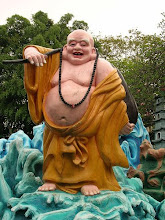Article from Bhagawan Ramana Maharishi's life
SERVICE OF ATMA SWARUPA IS ATMA SEVA
During the last two or three months, Bhagavan’s personal attendants have been massaging his legs with some medicated oil to relieve the rheumatic pain. Some of the devotees, zealous in attention to Bhagavan’s body, also began massaging by turn every half an hour, and this resulted in upsetting the usual Ashram routine.
Would Bhagavan tolerate all this? He was always considerate even to his personal attendants and would never say emphatically “No” to anything; so he said in a casual way,
“All of you please wait for a while, I will also massage these legs a little. Should I too not have some of the punyam (merit)?” So saying, he removed their hands and began massaging his own legs.
Not only was I very much amused at this but what little desire might have still been lurking in me to touch Sri Bhagavan’s lotus feet and thus perform pranam (salutation) was completely obliterated. Bhagavan’s words have a peculiar charm of their own! Look! He too wants a little of the punyam! What a delicate hint to those who have the intelligence to take it!
It was about that time that a retired judge of ripe old age said, “Swamiji, I should also be given my share of service to the feet of the Guru.”
To this Bhagavan replied. “Oh, really? Atma-vai guruhu! (Service to Self is service to Guru.) You are now 70 years of age. You to do service to me? Enough of that! At least from now onwards, serve yourself. It is more than enough if you remain quiet.”
When one comes to think about it, what greater upadesa (teaching) is there than this? Bhagavan says it is enough if
one can remain quiet. It is natural for him to do so, but are we capable of it? However much we try we do not attain that state. What else can we do than depend upon Sri Bhagavan’s Grace?
Letters from Sri Ramanasramam
SERVICE OF ATMA SWARUPA IS ATMA SEVA
During the last two or three months, Bhagavan’s personal attendants have been massaging his legs with some medicated oil to relieve the rheumatic pain. Some of the devotees, zealous in attention to Bhagavan’s body, also began massaging by turn every half an hour, and this resulted in upsetting the usual Ashram routine.
Would Bhagavan tolerate all this? He was always considerate even to his personal attendants and would never say emphatically “No” to anything; so he said in a casual way,
“All of you please wait for a while, I will also massage these legs a little. Should I too not have some of the punyam (merit)?” So saying, he removed their hands and began massaging his own legs.
Not only was I very much amused at this but what little desire might have still been lurking in me to touch Sri Bhagavan’s lotus feet and thus perform pranam (salutation) was completely obliterated. Bhagavan’s words have a peculiar charm of their own! Look! He too wants a little of the punyam! What a delicate hint to those who have the intelligence to take it!
It was about that time that a retired judge of ripe old age said, “Swamiji, I should also be given my share of service to the feet of the Guru.”
To this Bhagavan replied. “Oh, really? Atma-vai guruhu! (Service to Self is service to Guru.) You are now 70 years of age. You to do service to me? Enough of that! At least from now onwards, serve yourself. It is more than enough if you remain quiet.”
When one comes to think about it, what greater upadesa (teaching) is there than this? Bhagavan says it is enough if
one can remain quiet. It is natural for him to do so, but are we capable of it? However much we try we do not attain that state. What else can we do than depend upon Sri Bhagavan’s Grace?
Letters from Sri Ramanasramam









































